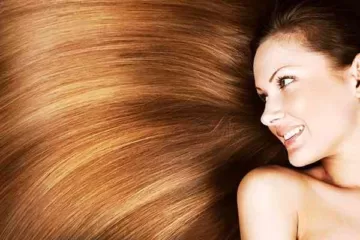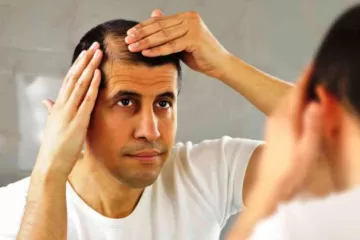Are you struggling with rough and unhealthy hair that lacks shine and vitality? Don’t worry, we’ve got you covered! In this blog post, we will provide you with valuable tips, tricks, and expert advice on how to effectively deal with rough and unhealthy hair. From understanding the causes to implementing a proper hair care routine, nourishing treatments, and lifestyle adjustments, you’ll learn how to transform your hair into luscious locks that radiate health and beauty.
1. Understanding the Causes of Rough and Unhealthy Hair
Understanding the causes of rough and unhealthy hair is crucial in addressing and improving its condition. Various factors can contribute to hair becoming rough and unhealthy, including excessive heat styling, chemical treatments like perming or coloring, improper hair care practices, environmental factors such as exposure to harsh weather conditions or pollution, and even underlying health issues. Additionally, factors like dehydration, nutrient deficiencies, and hormonal imbalances can impact hair health. By identifying and understanding the root causes of rough and unhealthy hair, individuals can take targeted steps to address these issues and restore their hair’s vitality and shine.
2. Establishing a Proper Hair Care Routine
Establishing a proper hair care routine is essential for maintaining healthy and manageable hair. A consistent routine ensures that your hair receives the care and attention it needs to thrive. Start by determining your hair type and specific concerns, such as dryness, frizz, or excessive oiliness. This knowledge will help you choose the right products and treatments. A basic hair care routine typically includes regular shampooing and conditioning with products suitable for your hair type. However, it’s important not to overwash your hair as it can strip away natural oils. Consider incorporating a weekly deep conditioning treatment to nourish and hydrate your strands. Additionally, use a wide-toothed comb or a brush with soft bristles to minimize breakage and damage. Finally, protect your hair from heat styling tools and excessive sun exposure by using heat protectant sprays and wearing a hat or scarf. Tailor your routine to fit your hair’s unique needs and adjust as necessary to achieve healthier, more vibrant locks.
2. Nourishing and Hydrating Your Hair
Nourishing and hydrating your hair is vital for combating roughness and maintaining its health and vitality. Start by ensuring your diet includes essential nutrients like vitamins A, C, E, and biotin, as they promote hair strength and growth. Additionally, hydrate your body by drinking an adequate amount of water each day to keep your hair and scalp hydrated from within. When it comes to external care, use a moisturizing shampoo and conditioner formulated for your hair type to lock in moisture. Incorporate a weekly or bi-weekly deep conditioning treatment or hair mask to provide intense nourishment. Consider using natural oils like coconut oil, argan oil, or jojoba oil as leave-in treatments or pre-shampoo treatments to restore moisture and add shine. Avoid excessive heat styling and opt for air-drying whenever possible to prevent further dehydration. By nourishing and hydrating your hair consistently, you can restore its softness, smoothness, and overall health.
3. Minimizing Heat and Chemical Damage
Minimizing heat and chemical damage is crucial for maintaining the health and integrity of your hair. Excessive heat styling, such as using flat irons, curling wands, or blow dryers at high temperatures, can lead to dryness, breakage, and frizz. To minimize heat damage, start by using heat protectant sprays or serums before applying any heat-styling tools. Set your styling tools to lower temperatures and avoid prolonged exposure to heat. Consider using alternative styling methods like heatless curls or air-drying techniques to give your hair a break from heat styling.
Chemical treatments, such as perming, relaxing, or coloring, can also cause damage if not done properly or with caution. It’s important to seek professional assistance for chemical treatments and ensure they are done by experienced stylists who prioritize the health of your hair. If possible, opt for gentler alternatives like semi-permanent dyes or ammonia-free products.
Regular trims are essential to remove split ends and prevent further damage. Trimming every 6-8 weeks helps maintain the overall health and appearance of your hair. Finally, remember to nourish and protect your hair with deep conditioning treatments and leave-in products specifically designed to repair and strengthen chemically treated hair. By minimizing heat and chemical damage, you can promote healthier hair growth and reduce the risk of long-term damage.
4. Incorporating Hair Masks and Treatments
Incorporating hair masks and treatments into your hair care routine can provide significant benefits in improving the health and appearance of your hair. Hair masks are intensive conditioning treatments that deliver deep hydration, nourishment, and repair to your strands. They are typically formulated with ingredients like natural oils, botanical extracts, proteins, and vitamins to target specific hair concerns such as dryness, damage, frizz, or lack of shine. To incorporate hair masks effectively, start by selecting a mask that suits your hair type and specific needs. Apply the mask to clean, damp hair and distribute it evenly from roots to ends. Gently massage the mask into your scalp to promote circulation. Leave the mask on for the recommended duration, allowing the ingredients to penetrate your hair shafts. Rinse thoroughly and follow up with your regular shampoo and conditioner. Aim to use a hair mask at least once a week, adjusting the frequency based on your hair’s condition. Additionally, consider incorporating leave-in treatments, such as serums or oils, to provide ongoing nourishment and protection between mask treatments. By regularly incorporating hair masks and treatments, you can revive and rejuvenate your hair, restoring its strength, softness, and lustrous appearance.
5. Choosing the Right Hair Products
Choosing the right hair products is crucial for maintaining the health and appearance of your hair. With a wide array of options available, it’s important to consider your hair type, specific concerns, and desired results when selecting products.
Start by identifying your hair type, whether it’s dry, oily, normal, or combination, as this will help you determine the right formulations. For example, if you have dry hair, opt for moisturizing shampoos and conditioners that provide hydration and nourishment. If you have oily hair, look for clarifying or volumizing products that can help control excess oil and add volume.
Consider your specific concerns, such as frizz, damage, or color-treated hair, and choose products that address those issues. Look for ingredients like argan oil, shea butter, keratin, or vitamins that can target your specific needs.
Pay attention to the product labels and avoid those containing harsh chemicals like sulfates, parabens, or silicones, as they can strip the hair of its natural oils and cause damage in the long run. Instead, opt for products labeled as sulfate-free, paraben-free, or made with natural and organic ingredients.
Don’t be afraid to experiment and try different brands and product lines until you find what works best for your hair. Consult with a hairstylist or read online reviews to gather recommendations and insights from others who have similar hair types and concerns.
Remember that hair needs can change with time, so periodically reassess your hair’s needs and adjust your product choices accordingly.
By selecting the right hair products tailored to your hair type and concerns, you can optimize the health, appearance, and manageability of your hair.
6. Protecting Your Hair from Environmental Factors
Protecting your hair from environmental factors is essential for maintaining its health and preventing damage. Environmental elements like sun exposure, pollution, humidity, and harsh weather conditions can have a detrimental impact on your hair. Here are some tips to protect your hair from these factors:
Sun Protection
Shield your hair from the sun’s harmful UV rays by wearing a hat, or scarf, or using a UV-protective hair spray or serum. This helps prevent dryness, color fading, and damage caused by prolonged sun exposure.
Pollution Defense
Wash your hair regularly to remove pollutants and residue that can accumulate from environmental pollution. Consider using clarifying shampoos or gentle detoxifying treatments to deeply cleanse your scalp and hair.
Humidity Control: In humid climates, frizz can be a common issue. Use anti-frizz products, such as serums or leave-in conditioners, to help manage and control frizz. Additionally, consider hairstyles that minimize frizz, like updos or braids.
Protection from Harsh Weather
Extreme weather conditions like wind, cold, and dry air can cause hair to become brittle and prone to breakage. Protect your hair by wearing a scarf or hat when outdoors in harsh weather. Additionally, use hydrating hair products and deep conditioning treatments to keep your hair moisturized.
Swimming Precautions
Chlorine and salt water can be damaging to your hair. Before swimming, wet your hair with fresh water and apply a leave-in conditioner or protective oil to create a barrier. After swimming, rinse your hair thoroughly and follow up with a clarifying shampoo to remove any residue.
Overnight Protection
Protect your hair while you sleep by using a satin or silk pillowcase or tying your hair in a loose, low-tension hairstyle like a loose braid or bun. This helps prevent friction and breakage while you sleep.
By taking proactive measures to protect your hair from environmental factors, you can minimize damage and keep your hair healthy, vibrant, and resilient.
7. Managing Stress and Maintaining a Healthy Lifestyle
Managing stress and maintaining a healthy lifestyle play significant roles in promoting overall hair health. Stress can contribute to hair problems such as hair loss, thinning, and dullness. Here are some tips for managing stress and maintaining a healthy lifestyle for better hair health:
Practice Stress Reduction Techniques
Incorporate stress reduction techniques into your daily routine, such as meditation, deep breathing exercises, yoga, or engaging in hobbies you enjoy. These activities can help alleviate stress and promote relaxation.
Get Regular Exercise
Regular physical activity can help improve blood circulation, including to the scalp, which promotes hair growth. Aim for at least 30 minutes of exercise most days of the week to reduce stress and improve overall well-being.
Prioritize Sleep
Adequate sleep is essential for maintaining healthy hair. Lack of sleep can disrupt the hair growth cycle and lead to increased hair shedding. Aim for 7-8 hours of quality sleep each night to support hair health.
Maintain a Balanced Diet
Eat a nutritious diet rich in vitamins, minerals, and protein to support healthy hair growth. Include foods such as fruits, vegetables, lean proteins, whole grains, and healthy fats. Consider incorporating hair-friendly nutrients like biotin, vitamin E, omega-3 fatty acids, and iron into your diet.
Hydrate
Drink an ample amount of water daily to keep your body and hair hydrated. Proper hydration supports scalp health and helps prevent dryness and brittleness.
8. Limit Heat Styling and Chemical Treatments
Excessive heat styling and chemical treatments can contribute to hair damage. Minimize the use of heat styling tools and opt for natural hairstyles whenever possible. If you do use heat styling, use a heat protectant spray and lower heat settings to minimize damage.
Take Breaks
Give your hair occasional breaks from styling and let it air-dry naturally. Embrace low-manipulation hairstyles to reduce stress on your hair strands.
By managing stress levels and maintaining a healthy lifestyle, you can create a favorable environment for hair growth and overall hair health.
Seeking Professional Advice and Treatments
Seeking professional advice and treatments is an important step in addressing specific hair concerns and ensuring optimal hair health. Here are some reasons why consulting with a professional can be beneficial:
Expert Assessment
Hair professionals, such as hairstylists, trichologists, or dermatologists, have extensive knowledge and experience in analyzing hair and scalp conditions. They can assess your hair’s health, identify underlying issues, and provide personalized recommendations.
Customized Treatment Plans
Professionals can create tailored treatment plans based on your specific hair needs. Whether you’re dealing with hair loss, scalp issues, or damaged hair, they can recommend appropriate treatments, products, and lifestyle changes to address your concerns effectively.
Professional Treatments
Hair professionals can offer specialized treatments that may not be available for home use. These treatments can include deep conditioning, scalp treatments, hair masks, or specialized salon procedures designed to nourish, repair, or rejuvenate your hair.
Advanced Techniques: Professionals are skilled in using advanced techniques, such as precision cutting, color correction, or chemical treatments, which require expertise and experience. They can help you achieve your desired hair goals while minimizing the risk of damage or undesirable outcomes.
Product Recommendations: Professionals can guide you in selecting the right hair products suited for your hair type, concerns, and desired results. They have knowledge of professional-grade products and can advise on the most suitable options for your specific needs.
Monitoring Progress: By seeking professional advice, you can have regular follow-up appointments to monitor the progress of your hair’s health and address any new concerns that may arise. This ongoing support and guidance can help you maintain and improve your hair’s condition.
When seeking professional advice, consider consulting with a reputable hairstylist, trichologist, or dermatologist who specializes in hair and scalp health. They can provide valuable insights, recommend appropriate treatments, and guide you towards healthier, more vibrant hair.
Remember, professional guidance should complement your overall hair care routine and be combined with consistent at-home care practices for optimal results.
9. Embracing Natural Remedies and DIY Hair Solutions
Embracing natural remedies and DIY hair solutions can be a cost-effective and sustainable approach to improving the health of your hair. While it’s important to consult with professionals for specific concerns, here are some natural remedies and DIY solutions that you can incorporate into your hair care routine:
Scalp Massage
Regularly massaging your scalp can stimulate blood flow, promote hair growth, and help distribute natural oils. Use your fingertips to gently massage your scalp in circular motions for a few minutes each day.
Homemade Hair Masks
Create nourishing hair masks using natural ingredients like avocado, banana, yogurt, honey, coconut oil, or aloe vera. These ingredients can provide deep hydration, repair damaged hair, and add shine. Apply the mask to clean, damp hair, leave it on for the recommended time, and rinse thoroughly.
Apple Cider Vinegar Rinse
Dilute apple cider vinegar with water and use it as a final rinse after shampooing to help restore the pH balance of your scalp and remove product buildup. This rinse can leave your hair shiny and smooth.
Essential Oil Treatments
Essential oils like lavender, rosemary, peppermint, or tea tree oil have beneficial properties for the hair. Dilute a few drops of your chosen essential oil with a carrier oil, such as coconut or jojoba oil, and massage it into your scalp or add it to your shampoo or conditioner for added benefits.
Herbal Infusions
Create herbal infusions using herbs like chamomile, nettle, rosemary, or green tea. Steep the herbs in hot water, let it cool, and use it as a final rinse or spray on your hair for added shine, scalp health, and promoting hair growth.
DIY Hair Rinse
Prepare a natural hair rinse by combining ingredients like lemon juice, chamomile tea, or brewed coffee to enhance shine, lighten hair color, or add depth to dark hair.
Remember to conduct a patch test before applying any DIY solution to ensure you are not allergic or sensitive to any ingredients. Additionally, these remedies and solutions may not provide immediate or drastic results, but consistent use over time can contribute to the overall health and appearance of your hair.
While embracing natural remedies and DIY solutions, it’s important to combine them with a balanced hair care routine and professional guidance for specific concerns to achieve the best results for your hair.




